Safe Canning Resources: Trusted Guides for Home Food Preservation
This post may contain affiliate links, which means that I may receive a commission if you make a purchase using these links. As an Amazon Associate I earn from qualifying purchases.
Looking for trusted, safe canning resources? This guide includes safe canning books and trusted websites that offer science-based, tested canning recipes to help you preserve food safely and confidently.
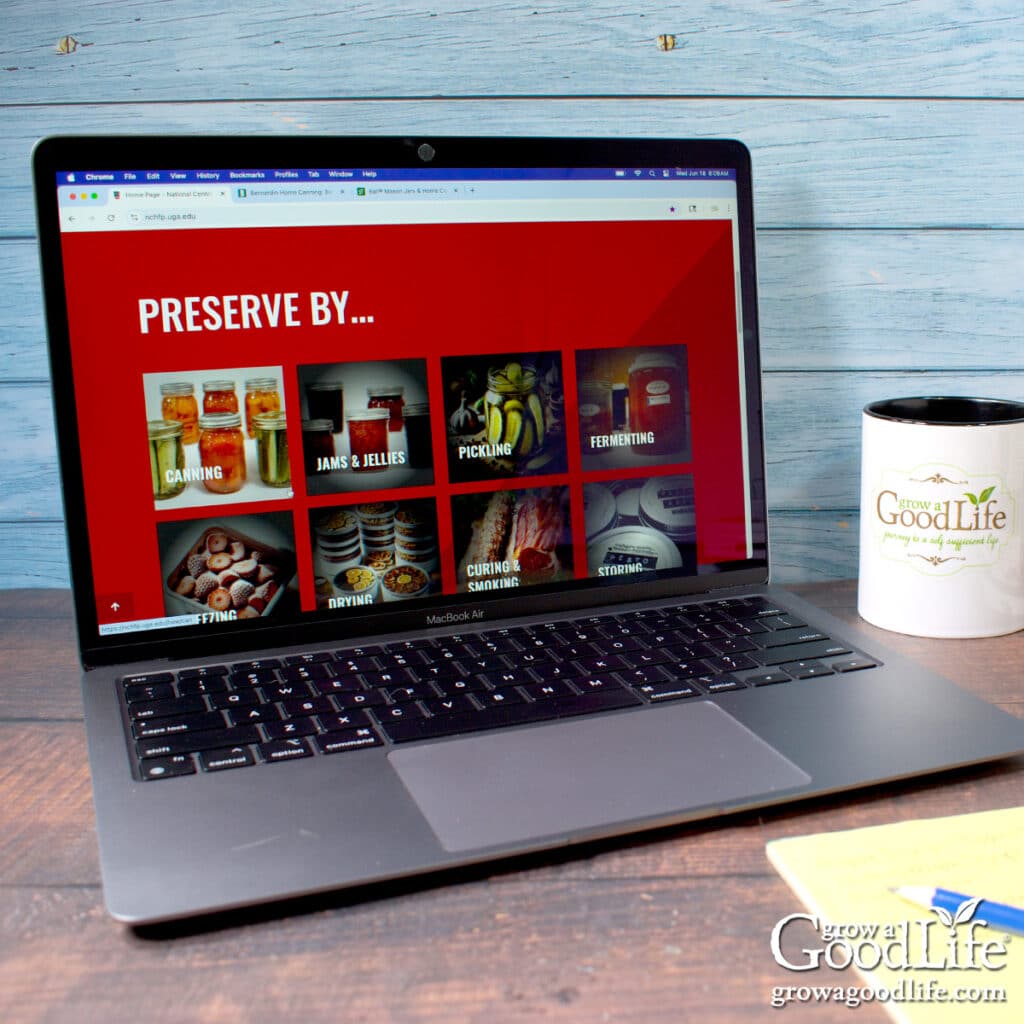
I was lucky when I first became interested in preserving food. I stumbled upon an online mentor, someone who was like a Granny to many of us learning the ropes. She welcomed questions with patience and kindness, and most importantly, she taught me the importance of canning safely.
It was she who suggested my first canning book: the Ball Blue Book Guide to Preserving. That basic book became my foundation, and her guidance helped me avoid the unsafe shortcuts that are all too common online. One of the first recipes I ever published on my website, Granny’s Bread and Butter Pickles, was inspired by her and named in her honor.
These days, it’s easy to get overwhelmed by the sheer number of canning recipes shared online and in books. Unfortunately, not all of them follow safe canning practices. Some influencers even promote unsafe methods and take an anything goes approach to home canning.
You may have also come across the term “rebel canning,” a trend where people deliberately ignore current safety guidelines. While the phrase might sound harmless or even fun, unsafe canning methods can lead to serious health risks, including botulism.
When you’re preserving the food you grew or sourced with care, it’s worth taking the extra step to ensure the recipes you use are safe for home canning. Reliable, science-based canning resources can help you preserve your harvest confidently, with recipes that have been lab-tested and guidelines that reflect current food safety standards.
In this article, I’m sharing the safe canning books and websites I personally trust and recommend, the same resources that helped me build a solid foundation in home food preservation.
What Is a Safe Tested Canning Recipe?
You will hear it a lot: Use a safe, tested canning recipe. But just what does that mean?
A safe tested canning recipe is one that has been developed and verified through scientific lab testing to ensure it can be processed safely at home using boiling water bath or pressure canning methods.
These recipes are carefully developed for flavor, texture, and safety. They are designed to prevent spoilage and protect against dangerous spores and microorganisms, especially Clostridium botulinum, the bacteria that causes botulism.
Food scientists test each recipe for things like:
- Acidity levels (pH)
- Density and consistency
- Jar size and headspace
- Processing time and method (water bath vs. pressure canning)
Safe tested recipes are published by trusted sources like the USDA, the National Center for Home Food Preservation (NCHFP), university extension services, and reputable companies like Ball and Bernardin. Following these recipes are your best protection against food borne illness and spoilage.
Trusted Resources for Safe Home Canning
When it comes to preserving your harvest at home, using safe, science-based canning recipes is important. Reliable canning resources, both books and websites, can help you stay up to date with tested recipes, current guidelines, and expert advice. The following resources are ones I personally trust and recommend.
Reliable Books for Safe Home Canning
A good canning book is one of the best investments you can make. I often turn to my trusted books to review tips or get inspired by seasonal recipes.
There are countless canning books on the market today, but not all of them follow current safety standards. The titles I recommend are based on science-backed, lab-tested recipes, follow USDA guidelines, and are written by food preservation experts.
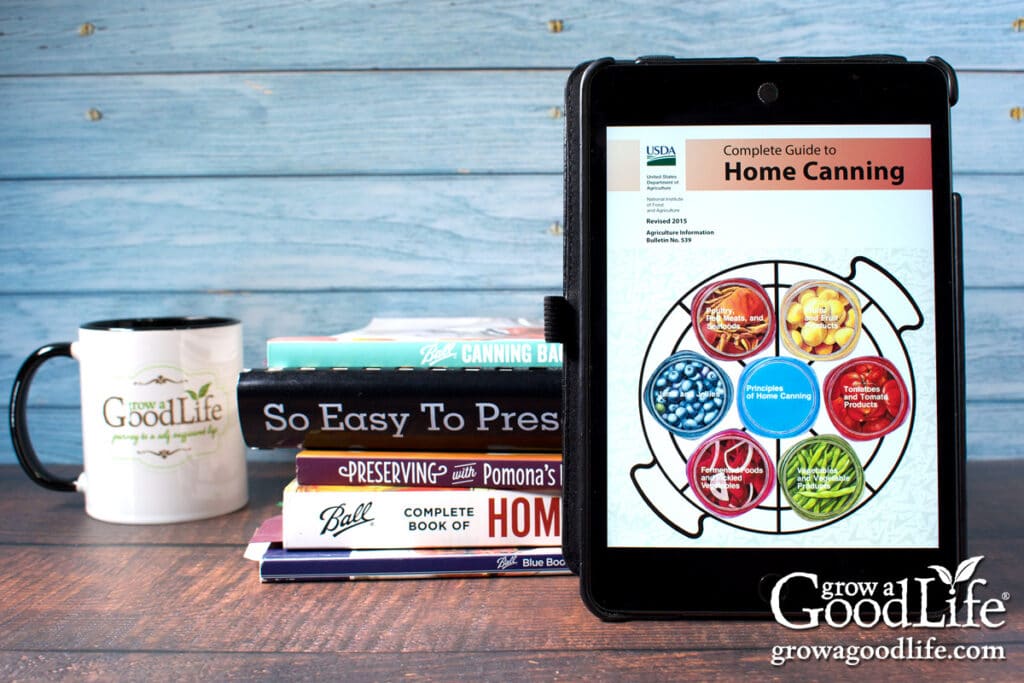
Here’s a quick look at some of my favorite safe canning books:
- Ball Blue Book Guide to Preserving
- Ball Complete Book of Home Preserving
- So Easy to Preserve by the University of Georgia
- The All New Ball Book of Canning and Preserving
- USDA Complete Guide to Home Canning
- Ball Canning Back to Basics
- Preserving with Pomona’s Pectin
👉 Want to learn more? Visit the full article for detailed descriptions of each book, updated editions, plus tips for choosing the right one for your needs: Safe Canning Books to Add to Your Library.
Reliable Websites with Recipes and Canning Advice
Alongside books, there are several websites I turn to again and again for up-to-date, science-based home canning information. These sites offer safe, tested recipes, current processing guidelines, and expert advice you can count on.
National Center for Home Food Preservation (NCHFP)
The NCHFP is the gold standard for safe home canning in the United States. It was established with support from the United States Department of Agriculture (USDA) and the University of Georgia to provide research-based recommendations for food preservation.
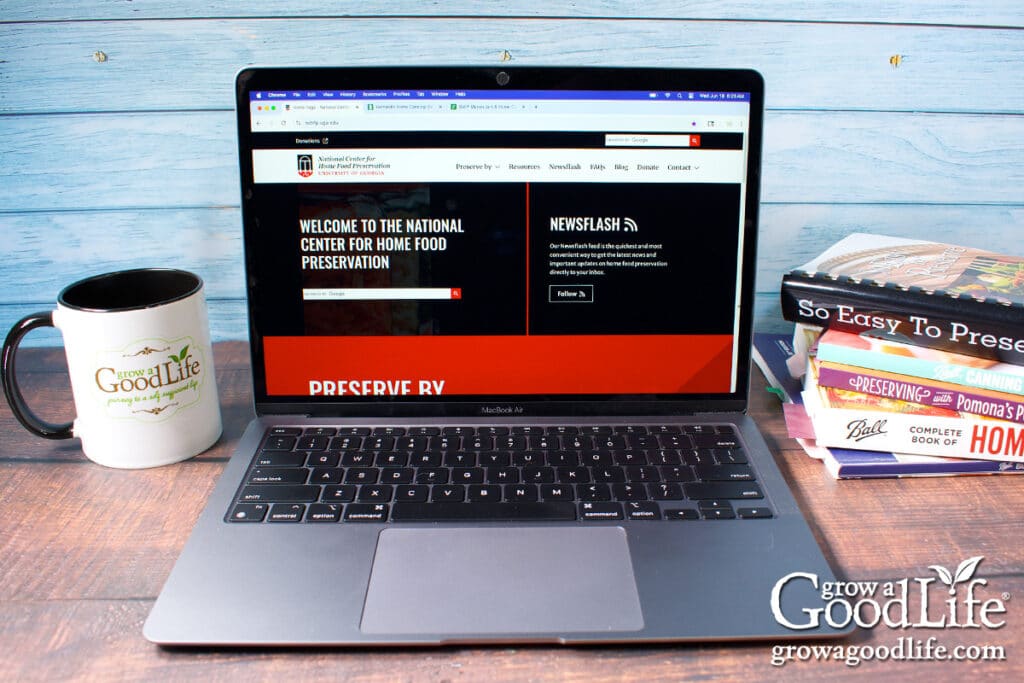
Here you’ll find:
- Safe canning recipes for fruits, vegetables, pickles, jams, meats, and more.
- Detailed guides for both water bath and pressure canning.
- Free downloadable version of the USDA Complete Guide to Home Canning
- Tips on food safety, equipment, and troubleshooting.
If you ever wondered how to safely home can something, this is one of the first places I suggest checking.
Ball Fresh Preserving
Ball has been a trusted name in home canning for generations. In addition to their famous books, jars, and lids, Ball offers canning recipes and canning tips on their official website: ballmasonjars.com.
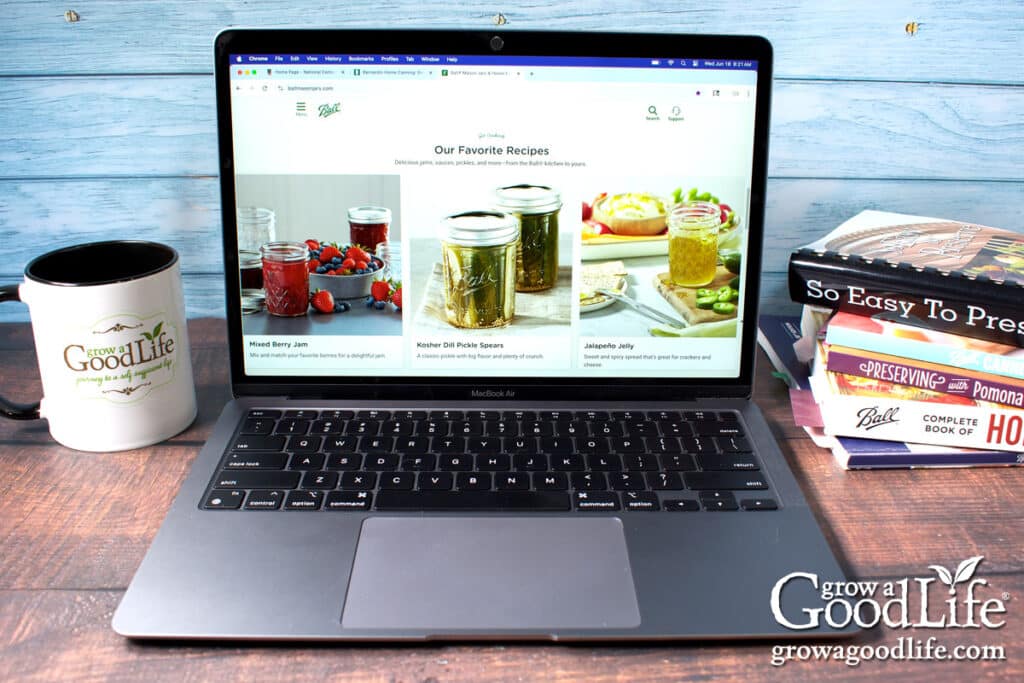
Their website offers:
- Safe canning recipes developed by Ball or in partnership with the NCHFP
- How-to guides and videos
- Product information for jars, lids, and tools
- A Facebook group to ask questions
Bernardin
Bernardin is Ball’s sister brand in Canada, and Newell Brands owns both. They follow the same science-based canning guidelines and safety standards. However, the Bernardin website offers a unique collection of recipes not found on the Ball site, making it a valuable complementary resource. You can find it here: Bernardin Home Canning.

Some standout recipes include:
- Québec Pork Meatballs: Flavorful pork meatballs seasoned with classic tourtière spices for a comforting, French-Canadian twist.
- Station Hot Sauce: A zesty blend of peppers and spices for homemade heat.
- Pork Sausage: An example of safely pressure-canned meat done the right way.
While the content is tailored for Canadian users, recipes include both metric and U.S. measurements, so they’re easy to follow no matter where you live.
Safe Jam, Jelly, and Preserves Recipes from Pectin Brands
Commercial pectin packages are another excellent source of safe, tested recipes if you’re making jams and jellies. Most boxes include a printed insert with step-by-step instructions, and many manufacturers also provide downloadable versions on their websites.
Because pectin types vary (regular, low- or no-sugar, liquid, or powdered), it’s important to follow the specific directions for the brand and variety you’re using to ensure the best results.
Popular pectin brands include:
- SURE-JELL Premium Fruit Pectin (Classic)
- SURE-JELL for Less or No Sugar
- CERTO Liquid Pectin
- MCP Pectin
- Ball RealFruit Classic Flex Batch Pectin
- Ball RealFruit Low or No Sugar Needed Flex Batch Pectin
- Mrs. Wages Fruit Pectin Home Jell
- Pomona’s Universal Pectin: Recipes in the insert and in the book Preserving with Pomona’s Pectin are lab-tested. However, user-submitted recipes on their website have not been tested for safety.
Extension Office Canning Guides and Regional Recipes
In addition to the National Center for Home Food Preservation, many university extension offices, as part of the U.S. Cooperative Extension System, do their own lab testing and provide trustworthy, research-based information on safe home canning.
They often feature unique, regionally adapted recipes and offer low-cost classes or workshops for hands-on learning. Many also provide dial-gauge testing to help ensure your equipment is accurate and safe to use.
🔍 Find your local extension office: USDA Land-Grant University Extension Directory
I often turn to these local extensions when I need fresh inspiration. For example, my local University of Maine Cooperative Extension shares safe-tested recipes for unique regional favorites like pickled fiddleheads and beach plum jelly, two popular foraged foods in my area.
Here are some of my favorite university extension websites to explore for reliable canning resources:
Penn State Extension
Penn State Extension is an excellent resource if you want to deepen your knowledge of food preservation. In addition to tested canning recipes, they offer helpful troubleshooting articles, educational videos, and online workshops. Their Let’s Preserve fact sheet series covers a wide range of topics from canning acidic foods to pressure canning meat and poultry.
North Dakota State University Extension (NDSU)
NDSU offers a wide range of downloadable guides on canning, including a guide that explains how to safely make limited changes to tested canning recipes. They also share regional fruit preserves you won’t find on NCHFP.
- Play It Safe! Safe Changes and Substitutions to Tested Canning Recipes
- Juneberry Jam
- Wild Grape Jelly
- Blackberry-Huckleberry Jam
University of Wyoming Extension
The Preserving Food in Wyoming guide features safe, research-based methods tailored to the state’s unique local foods. You’ll find unique canning instructions for wild fruits such as chokecherries, buffaloberries, gooseberries, and even prickly pear cactus jelly. Perfect for those looking to preserve regionally foraged ingredients.
University of Minnesota Extension
Minnesota Extension features some unique recipes that highlight wild and local ingredients. Their step-by-step tomato mixture recipe is a great example of a regionally adapted canning recipe. They also share recipes for unique fruit preserves like rose hip jam, rhubarb jam, and sandcherry jelly made from wild fruit.
- Minnesota Tomato Mixture: A unique tomato and vegetable combo safe for water bath canning.
- Rose Hip and Rhubarb Jam
- Sandcherry Jelly
Safe Canning Recipes and Resources from Grow a Good Life
Alongside the trusted books and websites listed above, I have developed a collection of safe canning recipes and resources to help you preserve your harvest with confidence. These recipes are rooted in research-backed guidelines and are designed to be delicious and safe for home canning.
Grow a Good Life Website
Over the years, I’ve spent countless hours making, testing, and sharing home-canning recipes that follow safe, science-based methods. Whether you’re preserving tomatoes, pickles, jams, fruit, salsa, or soups, you’ll find step-by-step instructions to make the process easy.
👉 Browse the full recipe collection: Safe Canning Recipes
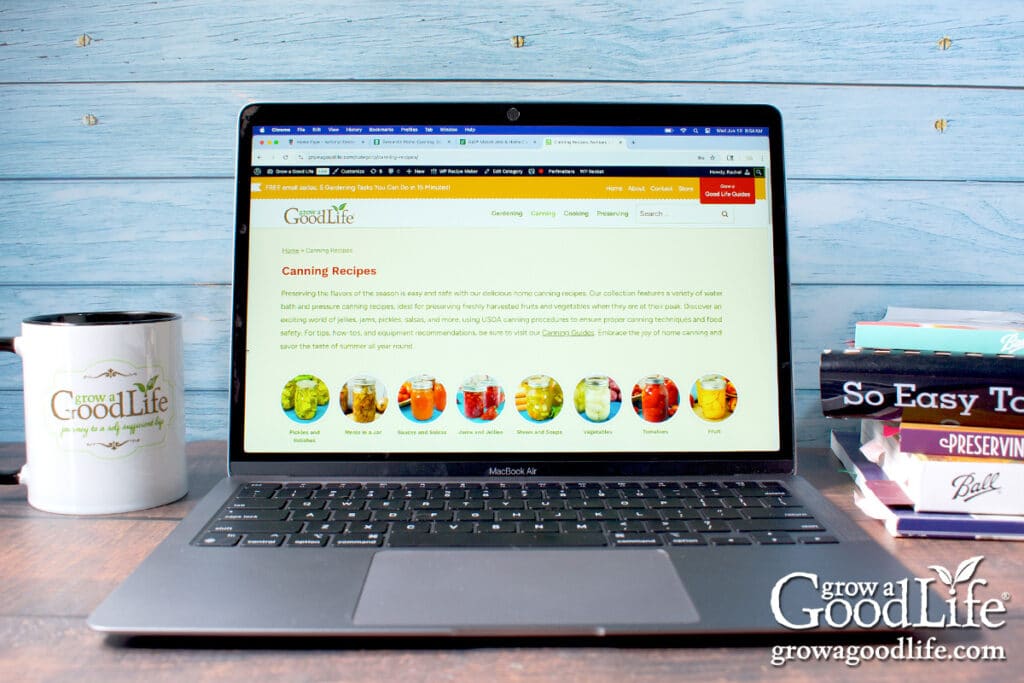
Grow a Good Life Guides
To make it even easier to find reliable recipes, I’ve curated collections of safe canning recipes in downloadable guides. These eBooks bring together favorites from thoroughly tested sources that follow USDA procedures, including So Easy to Preserve, Ball canning books, and the National Center for Home Food Preservation. Each recipe is carefully selected or adapted to meet current safety standards.
- Grow a Good Life Guide to 40+ Meals in a Jar Pressure Canning Recipes: A collection of hearty, ready-to-serve meals you can safely pressure can and enjoy anytime.
- Grow a Good Life Guide to 50 Salsa Canning Recipes: Discover creative and flavor-packed salsa recipes, all based on tested, safe, canning recipes.
Final Thoughts
Reliable resources are the foundation of safe and successful home canning. Whether you turn to a trusted book, bookmark a favorite website, or explore science-based recipes here at Grow a Good Life, having accurate information at your fingertips helps you preserve food with confidence and peace of mind.
I invite you to explore more canning guides on Grow a Good Life:
